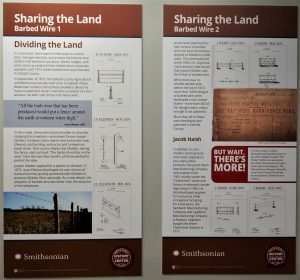Text:
Sharing the Land
Barbed Wire 1
Dividing the Land
In rural areas, there were limited ways to control land, manage livestock, and protect the harvest that settlers had worked to produce. Wood, hedges, and some stone provided all the reliable fence materials available until 1873, when barbed wire was invented in DeKalb County.
In September of 1873, the DeKalb County Agricultural and Mechanical Society held a fair in DeKalb. There, Waterman resident Henry Rose showed a device he had just patented. Rose’s invention consisted of a thin wooden rail with nails driven into fence wire.
In the crowd, three men stood shoulder to shoulder studying this invention—prominent farmer Joseph Glidden, hardware store owner and auctioneer Isaac Ellwood, and building contractor and lumberman Jacob Haish. One source relates that Glidden, seeing the fence, said out loud, “The barbs should be on the wire.” Over the next few months, all three worked to perfect the idea.
Joseph Glidden applied for a patent on October 27, 1873. Isaac Ellwood developed his own version of barbed wire but quickly partnered with Glidden to produce Glidden Wire nationally. As a new device, the adoption of barbed wire was faster than the adoption of the telephone.
[Inset]:
“All the barb wire that has been produced would put a fence around the earth seventeen wires high.” — Isaac Ellwood, 1907
Sharing the Land
Barbed Wire 2
Jacob Haish patented his own version of barbed wire, but soon launched a dispute of Glidden’s original claim. This eventually led to the 1892 U.S. Supreme Court decision that found that Joseph Glidden was the father of barbed wire.
While there was no reliable barbed wire before the fall of 1873, more than 3,000 designs of barbed wire were developed in the United States—more than 400 of the designs were unique enough to be patented.
More than 40 of these were designed and patented in DeKalb County.
Jacob Haish
In addition to corn shellers, fencing tools, and cream separators plus many other products, the Jacob Haish Manufacturing Company sold engines from 1905, mostly under the “Chanticleer” name and famous trademark rooster beginning in 1909. He also developed engines for numerous other companies including, for a few years, the Sandwich Manufacturing Company and Appleton Manufacturing Company in Batavia. Appleton bought the entire Chanticleer division in 1917.
But wait, there’s more!
Visit the Joseph F. Glidden Homestead and Historical Center to see where Glidden invented “The Winner” barbed wire and explore the exhibits that examine its impact on the nation’s development. The Ellwood House Museum reflects the central role of Isaac Ellwood and the development of barbed wire in America.




